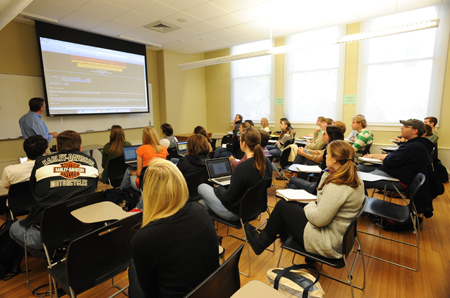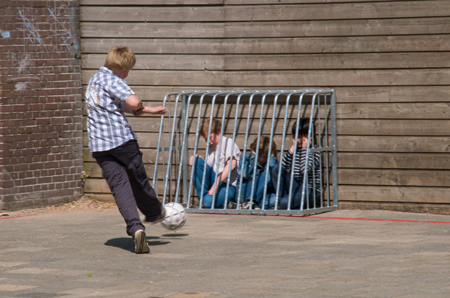Chapter 6. Education
5.2. Theoretical Perspectives on Education
5.2. Theoretical Perspectives on Education
While it is clear that education plays an integral role in individuals’ lives as well as society as a whole, sociologists view that role from many diverse points of view. Functionalists believe that education equips people to perform different functional roles in society. Critical sociologists view education as a means of widening the gap in social inequality. Feminist theorists point to evidence that sexism in education continues to prevent women from achieving a full measure of social equality. Symbolic interactionists study the dynamics of the classroom, the interactions between students and teachers, and how those affect everyday life. In this section, you will learn about each of these perspectives.
Functionalism
Functionalists view education as one of the more important social institutions in a society. They contend that education contributes two kinds of functions: manifest (or primary) functions, which are the intended and visible functions of education; and latent (or secondary) functions, which are the hidden and unintended functions.
Manifest Functions
There are several major manifest functions associated with education. The first is socialization. Beginning in preschool and kindergarten, students are taught to practise various societal roles. The French sociologist Émile Durkheim (1858–1917), who established the academic discipline of sociology, characterized schools as “socialization agencies that teach children how to get along with others and prepare them for adult economic roles” (Durkheim 1898).
This socialization also involves learning the rules and norms of the society as a whole. In the early days of compulsory education, students learned the dominant culture. Today, since the culture of Canada is increasingly diverse, students may learn a variety of cultural norms, not only that of the dominant culture.
School systems in Canada also transmit the core values of the nation through manifest functions like social control. One of the roles of schools is to teach students conformity to law and respect for authority. Obviously, such respect, given to teachers and administrators, will help a student navigate the school environment. This function also prepares students to enter the workplace and the world at large, where they will continue to be subject to people who have authority over them. Fulfillment of this function rests primarily with classroom teachers and instructors who are with students all day.

Education also provides one of the major methods used by people for upward social mobility. This function is referred to as social placement. University and graduate schools are viewed as vehicles for moving students closer to the careers that will give them the financial freedom and security they seek. As a result, university students are often more motivated to study areas that they believe will be advantageous on the social ladder. A student might value business courses over a class in Victorian poetry because he or she sees business class as a stronger vehicle for financial success.
Latent Functions
Education also fulfills latent functions. Much goes on in school that has little to do with formal education. For example, you might notice an attractive fellow student when he gives a particularly interesting answer in class — catching up with him and making a date speaks to the latent function of courtship fulfilled by exposure to a peer group in the educational setting.
The educational setting introduces students to social networks that might last for years and can help people find jobs after their schooling is complete. Of course, with social media such as Facebook and LinkedIn, these networks are easier than ever to maintain. Another latent function is the ability to work with others in small groups, a skill that is transferable to a workplace and that might not be learned in a homeschool setting.
The educational system, especially as experienced on university campuses, has traditionally provided a place for students to learn about various social issues. There is ample opportunity for social and political advocacy, as well as the ability to develop tolerance to the many views represented on campus. In 2011, the Occupy Wall Street movement swept across university campuses all over Canada, leading to demonstrations in which diverse groups of students were unified with the purpose of changing the political climate of the country.
| Manifest Functions: Openly stated functions with intended goals | Socialization | Transmission of culture | Social control | Social placement | Cultural innovation |
|---|---|---|---|---|---|
| Latent Functions: Hidden, unstated functions with sometimes unintended consequences | Courtship | Social networks | Working in groups | Creation of generation gap | Political and social integration |
Functionalists recognize other ways that schools educate and enculturate students. One of the most important values students in Canada learn is that of individualism — the valuing of the individual over the value of groups or society as a whole. In countries such as Japan and China, where the good of the group is valued over the rights of the individual, students do not learn as they do in Canada that the highest rewards go to the “best” individual in academics as well as athletics. One of the roles of schools in Canada is fostering self-esteem; conversely, schools in Japan focus on fostering social esteem — the honouring of the group over the individual.
In Canada, schools also fill the role of preparing students for competition and cooperation in life. Obviously, athletics foster both a cooperative and competitive nature, but even in the classroom, students learn both how to work together and how to compete against one another academically. Schools also fill the role of teaching patriotism. Although Canadian students do not have to recite a pledge of allegiance each morning, like students in the United States, they do take social studies classes where they learn about common Canadian history and identity.

Another role of schools, according to functionalist theory, is that of sorting, or classifying students based on academic merit or potential. The most capable students are identified early in schools through testing and classroom achievements. Exceptional students are often placed in accelerated programs in anticipation of successful university attendance. Other students are guided into vocational training programs with emphasis on shop and home economics.
Functionalists also contend that school, particularly in recent years, is taking over some of the functions that were traditionally undertaken by family. Society relies on schools to teach about human sexuality as well as basic skills such as budgeting and job applications — topics that at one time were addressed by the family.
Critical Sociology
Critical sociologists do not believe that public schools reduce social inequality. Rather, they believe that the educational system reinforces and perpetuates social inequalities arising from differences in class, gender, race, and ethnicity. Where functionalists see education as serving a beneficial role, critical sociologists view it more critically. To them, it is important to examine how educational systems preserve the status quo and guide people of lower status into subordinate positions in society.

The fulfillment of one’s education is closely linked to social class. Students of low socioeconomic status are generally not afforded the same opportunities as students of higher status, no matter how great their academic ability or desire to learn. For example, 25 of every 100 low-income Canadian 19-year-olds attend university compared to 46 of every 100 high-income Canadian 19-year-olds (Berger, Motte, and Parkin 2009). Barriers like the cost of higher education, but also more subtle cultural cues, undermine the promise of education as a means of providing equality of opportunity.
Picture a student from a working-class home who wants to do well in school. On a Monday, he’s assigned a paper that’s due Friday. Monday evening, he has to babysit his younger sister while his divorced mother works. Tuesday and Wednesday he works stocking shelves after school until 10:00 p.m. By Thursday, the only day he might have available to work on that assignment, he is so exhausted he cannot bring himself to start the paper. His mother, though she would like to help him, is so tired herself that she isn’t able to give him the encouragement or support he needs. Since English is her second language, she has difficulty with some of his educational materials. They also lack a computer and printer at home, which most of his classmates have, so they have to rely on the public library or school system for access to technology. As this story shows, many students from working-class families have to contend with helping out at home, contributing financially to the family, having poor study environments, and lacking material support from their families. This is a difficult match with education systems that adhere to a traditional curriculum that is more easily understood and completed by students of higher social classes.
Such a situation leads to social class reproduction, extensively studied by French sociologist Pierre Bourdieu. He researched how, parallel to economic capital (as analyzed by Marx), cultural capital, or the accumulation of cultural knowledge that helps one navigate a culture, alters the experiences and opportunities available to French students from different social classes. Bourdieu emphasized that like economic capital, cultural capital in the form of cultural taste, knowledge, patterns of speech, clothing, proper etiquette, etc. is difficult and time consuming to acquire. Members of the upper and middle classes have more cultural capital than families of lower-class status, and they can pass it on to their children from the time that they are toddlers. As a result, the educational system maintains a cycle in which the dominant culture’s values are rewarded. Instruction and tests cater to the dominant culture and leave others struggling to identify with values and competencies outside their social class. For example, there has been a great deal of discussion over what standardized tests such as the IQ test and aptitude tests truly measure. Many argue that the tests group students by cultural ability rather than by natural intelligence.
The cycle of rewarding those who possess cultural capital is found in formal educational curricula as well as in the hidden curriculum, which refers to the type of nonacademic knowledge that one learns through informal learning and cultural transmission. The hidden curriculum is never formally taught but it is implied in the expectation that those who accept the formal curriculum, institutional routines, and grading methods will be successful in school. This hidden curriculum reinforces the positions of those with higher cultural capital, and serves to bestow status unequally.
Critical sociologists also point to tracking, a formalized sorting system that places students on “tracks” (advanced versus low achievers) that perpetuate inequalities. While educators may believe that students do better in tracked classes because they are with students of similar ability and may have access to more individual attention from teachers, critical sociologists feel that tracking leads to self-fulfilling prophecies in which students live up (or down) to teacher and societal expectations (Education Week 2004).
As noted above, IQ tests have been attacked for being biased — for testing cultural knowledge rather than actual intelligence. For example, a test item may ask students what instruments belong in an orchestra. To correctly answer this question requires certain cultural knowledge — knowledge most often held by more affluent people who typically have more exposure to orchestral music. On the basis of IQ and aptitude testing, students are frequently sorted into categories that place them in enriched program tracks, average program tracks, and special needs or remedial program tracks. Though experts in testing claim that bias has been eliminated from tests, conflict theorists maintain that this is impossible. The tests are another way in which education does not provide equal opportunities, but instead maintains an established configuration of power.
Feminist Theory
Feminist theory aims to understand the mechanisms and roots of gender inequality in education, as well as their societal repercussions. Like many other institutions of society, educational systems are characterized by unequal treatment and opportunity for women. Almost two-thirds of the world’s 862 million illiterate people are women, and the illiteracy rate among women is expected to increase in many regions, especially in several African and Asian countries (UNESCO 2005; World Bank 2007).
In Canada women’s educational attainments have since the early 1980’s surpassed that of men. Women now make up 56% of all post-secondary students and 58% of graduates from post-secondary institutions in Canada (Statistics Canada, 2013). Canadian women in fact have the highest percentage of higher educational attainment among all OECD countries at 55%. A university education is also more financially advantageous for women in Canada than men relatively speaking. Women with a higher education degree earn on average 50% more than they would without higher education compared to 39% more for men. However, men with higher education were more likely to have a job than women with higher education (84.7% to 78.5%), and women earned less than men in absolute terms with their education: 74 cents for each dollar earned by men for ages 24 to 64 (OECD, 2012). From a feminist perspective, women might be staying longer in school as they need this to compete in an unequal job market.
A Statistics Canada study released in 2011 showed that, among full-time employed men and women aged 25 to 29 with a graduate or professional degree, women still earned only 96 cents for every dollar earned by men in 2005. (With a bachelor`s degree they earned 89 cents for every dollar earned by men.) This trend was similar among all fields of study except for physical and life sciences, and technologies and health, parks, recreation and fitness where women actually earned more than men (Turcotte, 2011).
When women face limited opportunities for education, their capacity to achieve equal rights, including financial independence, are limited. Feminist theory seeks to promote women’s rights to equal education (and its resultant benefits) across the world.
Grade Inflation: When Is an A Really a C?
Consider a large-city newspaper publisher. Ten years ago, when culling résumés for an entry-level copywriter, they were well assured that if they selected a grad with a GPA of 3.7 or higher, they would have someone with the writing skills to contribute to the workplace on day one. But over the last few years, they have noticed that A-level students do not have the competency evident in the past. More and more, they find themselves in the position of educating new hires in abilities that, in the past, had been mastered during their education.
This story illustrates a growing concern referred to as grade inflation — a term used to describe the observation that the correspondence between letter grades and the achievements they reflect has been changing (in a downward direction) over time. Put simply, what used to be considered C-level, or average, now often earns a student a B, or even an A. For example, in 2010, 70% of first-year students in Canadian universities reported having an A-minus average or greater in high school, and increase of 40% from the early 1980s (Dehaas, 2011).
Why is this happening? Research on this emerging issue is ongoing, so no one is quite sure yet. Some cite the alleged shift toward a culture that rewards effort instead of product (i.e., the amount of work a student puts in raises the grade, even if the resulting product is poor quality). Another oft-cited contributor is the pressure many of today’s instructors feel to earn positive course evaluations from their students — records that can tie into teacher compensation, award of tenure, or the future career of a young grad teaching entry-level courses. The fact that these reviews are commonly posted online exacerbates this pressure.
Other studies do not agree that grade inflation exists at all. In any case, the issue is hotly debated, with many being called upon to conduct research to help us better understand and respond to this trend (Mansfield 2001; National Public Radio 2004).
Symbolic Interactionism
Symbolic interactionism sees education as one way that the labelling theory can be demonstrated in action. A symbolic interactionist might say that this labelling has a direct correlation to those who are in power and those who are being labelled. For example, low standardized test scores or poor performance in a particular class often lead to a student being labelled as a low achiever. Such labels are difficult to “shake off,” which can create a self-fulfilling prophecy (Merton 1968).
In his book High School Confidential, Jeremy Iverson details his experience as a Stanford graduate posing as a student at a California high school. One of the problems he identifies in his research is that of teachers applying labels that students are never able to lose. One teacher told him, without knowing he was a bright graduate of a top university, that he would never amount to anything (Iverson 2006). Iverson obviously didn’t take this teacher’s false assessment to heart. However, when an actual 17-year-old student hears this from a person with authority, it is no wonder that the student might begin to “live down to” that label.
The labelling with which symbolic interactionists concern themselves extends to the very degrees that symbolize completion of education. Credentialism embodies the emphasis on certificates or degrees to show that a person has a certain skill, has attained a certain level of education, or has met certain job qualifications. These certificates or degrees serve as a symbol of what a person has achieved, allowing the labelling of that individual.
Indeed, as these examples show, labelling theory can significantly impact a student’s schooling. This is easily seen in the educational setting, as teachers and more powerful social groups within the school dole out labels that are adopted by the entire school population.

